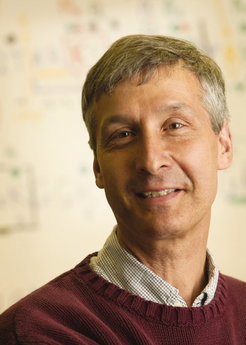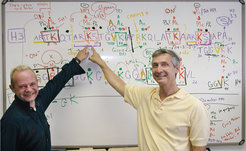In memoriam David Allis (1951-2023)
Eine Retrospektive von Thomas Jenuwein (nur auf Englisch)
Father of histone modifications, king of chromatin
David Allis, a pioneer in histone modifications and chromatin biology died from cancer on January 8, 2023 at the age of 71 years. The scientific community has lost one of its most inspirational leaders, an outstanding scientist and an engaged and supportive colleague. His legacy will shine forever.

Chromatin with its basic subunits, the histone proteins, is the physiological template of our genetic information, the DNA double helix. When David Allis started his chromatin work in mid 1980, no specific enzymes for histone modifications were known, nor were the functions of histone modifications. His seminal discovery of the first histone acetyltransferase (HAT), p55/GCN5, in 1996 combined insights from earlier biochemical studies on the transcriptionally active macronucleus in Tetrahymena and genetic work on gene activation in budding yeast. These break-through findings established a functional mechanism for histone acetylation and the formation of an active chromatin state and identified the enzyme class for histone lysine acetylation that had been elusive since the mid 1960.
Since the ciliate p55 HAT enzyme has a signature catalytic domain, it immediately allowed the enzymatic characterization of related HAT enzymes that define transcriptional stimulation of gene activity. The enzymatic dissection of histone modifications by histone lysine acetylation had direct functional implications for gene expression and chromatin stability and defined an epigenetic contribution to human disease and aging. Notably for cancer, dysregulation of histone modifications has far-reaching implications and has lead to new avenues of treatment, now known as epigenetic therapy. The ground-breaking studies of David Allis in identifying the first HAT in the year 1996 opened the entire field of epigenetic control for the functional analysis of histone modifications and stands as one of the biggest landmark discoveries in chromatin research during the last three decades.
From basic science to medical impact for human health
The definition of the first nuclear HAT has been more than the beginning of an impressive series of outstanding and instrumental publications that have formed the modern era of chromatin and epigenetic research. This included the functional description of histone modifying enzymes (“writer enzymes”) and the characterization of binding factors to histone modifications (“reader factors”), exemplified by bromodomains for histone acetylation and chromodomains for histone methylation. Early on, David Allis recognized the combinatorial nature of histone modifications, both in enhancing or in suppressing additional histone marks. His conceptual thinking was first described in “The language of covalent histone modifications” (2000) and then in “Translating the histone code” (2001). David Allis extended his studies from Tetrahymena and budding yeast to mouse ES cells and human cancer. He has been instrumental for the epigenetic profiling of cell type identities, allowing for the description of ‘bivalent chromatin’ in undifferentiated ES cells. With EpiGenetiX, one of the first pharmaceutical start-up companies to explore translational potential of epigenetic research (2003-2008), David Allis has been one to suggest small molecule inhibitors that would block access of “reader” factors to chromatin and be of use in epigenetic therapy for cancer treatment. These insights were taken forward into the development of BET inhibitors (that deter binding of Bromodomain and Extra-Terminal proteins to histone acetylation) (2010). David Allis also identified point mutations in histones in various forms of cancer, leading to the description of “onco-histones”, such as mis-sense mutations (H3K27M) in pediatric gliomas (2013) and H3K36M mutations in chondroblastomas and sarcomas (2017). The research of David Allis has been spanning from basic science on the molecular mechanisms of histone modifications, chromatin dynamics and cell type identities to their medical relevance and impact for human health and disease treatment.
I have known David Allis for more than 25 years and we first met when I was a very junior PI at the IMP in Vienna and he was an invited speaker (around 1996). I then had additional interactions at the Snowmass FASEB Chromatin Conference (1998), where I could only present a poster on our work of mammalian orthologs of Drosophila PEV modifier factors and he had published his seminal work on the p55/GCN5 HAT. After this conference, we had discovered (with the help of Gunter Reuter and Frank Eisenhaber) that one of these mammalian orthologs of Drosophila PEV modifier factors, SUV39H1, could methylate histone H3. We had no expertise in the biochemical analysis of histone modifications and I contacted David Allis for a collaboration. David immediately agreed, despite his own interest in his lab (primarily Brian Strahl) to also find histone methylating enzymes. We did send the recombinant SUV39H1 protein to his lab (then in Charlottesville, University of Virginia), and Brian Strahl and Zu-Wen Sun did in vitro methyltransferase assays and mass-spec analyses. This led to the definition of the substrate specificity of SUV39H1. A transatlantic phone call (David Allis from Charlottesville to Vienna) still rings today: “Thomas, can you believe it, it is H3K9 !!!”. To both David and myself, this has been a sign of true epigenetic magic, as if the genetic nomenclature of Drosophila Su(var)3-9 predicted the biochemical activity of the encoded enzyme to methylate histone H3 on lysine 9. This work, published in 2000, identified the first nuclear histone methyltransferase (HMT) and defined the class of SET domain HMT enzymes.
Translating the histone code
Our interactions continued with the next questions on identifying binding factors that could possibly “read” histone modifications (for example binding of HP1 to H3K9 methylation) and on the development of specific antibodies for the detection of histone modifications. During this time, David was approached by Science to write a review and he asked me whether I would like to join, so that we could connect our expertises in histone modifications and epigenetic control. This led to the highly-cited Science review ”Translating the histone code” (2001). Although there has been much debate, the “histone code hypothesis” has never been a religion, but rather an inspirational framework for the complexity of histone modifications that has helped to formulate research proposals and to build scientific careers. David would indeed have been very happy to see the many positive responses on the “histone code hypothesis” that had been put on Twitter, immediately after the tragic news of his too early passing were available on the internet.
The detection of histone modifications has been challenging and the specificity of antibodies is crucial, particularly if there are three distinct methylation states (e.g. H3K9me1 (mono), H3K9me2 (di) and H3K9me3 (tri)). Both of our labs developed and quality controlled antibodies for the analysis of histone modifications. This has been important and helped to define different activities and functions of histone methylation states for H3K4, H3K9, H3K27 and H4K20 (2001-2004). We had many requests for the use of these antibodies, and, with the exception of one antibody, these requests could be answered. The exceptional antibody was the infamous “golden bleed” of a rabbit antiserum that only worked from a batch that could be recovered from a crashed plane that did not make it all the way to Charlottesville. Although this “golden bleed” (an H3K9me2 antiserum) was in high demand, it was low in supply.

Chromatin and epigenetic research was on an ever-rising high and the field was exploding with publications that now allowed for a functional dissection of epigenetic mechanisms and investigations on the enzymatic systems that can build active (“euchromatin”) or repressed (“heterochromatin”) chromatin. Cold Spring Harbor Laboratories considered the need for a leading textbook in Epigenetics and invited Danny Reinberg to bring this project forward. Danny then asked David Allis and myself to join in a team that would work as editors (with the additional help of Marie-Laure Caparros and then also Monika Lachner). Brainstorming and preparations for the Epigenetics textbook started at the wooden bench outside the Snowmass Conference Center (around 2004), were continued during other meetings (with much needed cocktails at the beaches in Cancun) and in the New York offices of Danny Reinberg (NYU) and David Allis (Rockefeller). There, in the office of David Allis, was the holy grail of histone research: his famous whiteboard where he had colored every amino acid in all the histone tails (Figure 1). He had moved this whiteboard from Charlottesville, University of Virginia to Rockefeller University New York and once you had the privilege to be invited to his office you could see him ‘think-tanking’ about every amino acid in the histone molecules. It was during these times (2004-2007) and in the concerted efforts on the Epigenetics textbook that our friendships deepened. His fascination and insight in describing the complexity of histone and chromatin regulation is beautifully reflected in the overview chapter (more than 70 pages!) of the first (2007) and second (2015) edition of the CSHL textbook “Epigenetics”. During our meetings, I also learned about his passion for ‘punts’ and to phrase or rephrase intricate molecular chromatin mechanisms into more popular language. This included, among others, “switches” (for antagonizing histone modifications), “taking your HAT off” (for histone deacetylases) or “being in a good neighborhood” (for active chromatin or euchromatin). Although the focus of our research has been heterochromatin (repressive chromatin or a “bad neighborhood”), I could not have been in a better team than with David and Danny and I enjoyed every minute of our interactions. Another ‘punt’ has been that David gave us towels labeled as “Histones” and “Hertones” to ease off the efforts with the work on two editions of the CSHL Epigenetics textbook.
David Allis celebrated his 60th birthday at Rockefeller University in 2011 with a gathering of lab members, colleagues and friends. I could not participate in person but did send him a chromatin model and my best wishes. He responded with a picture showing him with the chromatin model in front of the whiteboard and a card with a picture assembly where all the birthday participants were having HATs on. My latest direct interaction with David has been for the Nature Review Genetics work in 2016. I was approached by Nature Review Genetics to write about a timeline of the major discoveries in epigenetic research during the last 20 years. Without hesitation, I called David and asked him to join for this review. Our interactions for this piece were as enjoyable and productive as ever and we had an agreed outline with the first phone call. We could finish this review “The molecular mechanisms of epigenetic control” (2016) with ease and in our mutual friendship. After 2016, my interactions with David Allis and his participation at scientific meetings became less frequent and I was only hoping that he would be doing well.
The seminal research of David Allis has been recognized with many highly prestigious prizes (only a selection is listed): John Wiley Prize (2004), election to the National Academy of Sciences (2005), Gairdner International Award (2007), Rosenstiel Award (2011), Japan Prize (2014), Breakthrough Prize (2015), Lasker Award (2017) and the Albany Medical Center Prize (2022). I very much wished he could have been given the Nobel Prize, which would have been more than deserved.
One of the signature sentences of David Allis was: “Every amino acid in the histones counts”. There, then, must be a higher blessing and another sign of epigenetic magic, such that in an amino acid segment of the histone H3 C-terminus, the letters “DAVID” can be found.
104…D….A…..V.I…D…129
The chromatin community is standing on the shoulders of a giant and we will miss one of the most inspirational scientists and a true friend. His legacy will shine forever.

